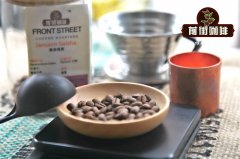What are the characteristics of coffee varieties grown in Burger Manor, Mexico?

Professional coffee knowledge exchange more coffee bean information please follow the coffee workshop (Wechat official account cafe_style)
Coffee first came to Mexico around 1785. According to the literature, there were coffee plantations in the Veracruz area in 1790. However, because of Mexico's rich mineral deposits, the coffee industry has had relatively little similar momentum over the years.
Mexico's first large-scale land registration began with a border dispute with neighboring Guatemala, allowing wealthy Europeans to buy large tracts of land and be willing to invest in the infrastructure needed to grow coffee. This forced the aborigines to move to the mountains and from time to time attracted them down to work in the plantations.
It was only after the Mexican Revolution ended in 1920 that small farmers began to grow coffee. Land was redistributed to aborigines and labourers in 1914, and many people who had previously been forced to work on coffee plantations were finally liberated to return to their communities and bring back coffee-growing skills. The redistribution of land also broke the monopoly of large estates and announced the beginning of the era of small coffee farmers in Mexico.
Mexico, located at the northern tip of Central America, is the fourth largest coffee producer in the world. The vast majority of Mexican coffee is washed Arabica coffee, which is characterized by a very strong special aroma, a bit like overfermented fruit.
The most impressive Mexican coffee beans are giant baby beans-elephant beans. Elephant beans (Maragogype) are at least three times larger than the average Arabica, winning everyone's attention for their huge size. Xiang Doujun is very suitable to live in the low altitude area of 700-800 meters, because the life in the low altitude area is too comfortable, so the elephant bean gentleman here is mediocre and has no characteristics. But when Xiang Doujun lives at an altitude of more than 1000 meters, they show extraordinary charm-mild sour taste and sweet fragrance.
Are you familiar with elephant beans? Most of the elephant beans are produced in Central America, especially in Mexico and Guatemala, because the quantity is rare, it is not easy to collect, and the price is slightly on the high side, but because of the elegant taste, sweetness and milk chocolate, a large number of nutty aromas emerge in the middle, caramel aroma emerges when the temperature in the latter section is getting lower, and the finish rhyme has a sweet fragrance of cilantro flowers, smooth taste and strong return to sweet taste. Therefore, it is also known as (the Great Blue Mountain).
Chiapas is located in the southernmost part of Mexico, the coffee beans bred by the high altitude of 2500m to 4000m and fertile volcanic soil have a smooth taste and moderate acidity, and have won the UTZ "good Coffee Certification". The palate is mild and full of delicate aromas, with mild acidity on the palate, creamy silky and smooth, with a finish of drupes, nuts and spices.
Variety: maragogype elephant bean
Producing area: Chiapas of Chiapas region
Manor: Hamburg Manor
Altitude: 1250-1550 m
Harvest time: November-March
Treatment method: washing treatment method
Flavor: milk, chocolate, slight lime, fruity aroma
Important Notice :
前街咖啡 FrontStreet Coffee has moved to new addredd:
FrontStreet Coffee Address: 315,Donghua East Road,GuangZhou
Tel:020 38364473
- Prev

Coffee prices in Indonesia are polarized, venture capital and start-ups aim at the mid-market
Professional coffee knowledge exchange more coffee bean information please follow the coffee workshop (Wechat official account cafe_style) Indonesia coffee prices are polarized, venture capital and start-ups targeting the mid-market Indonesia is the world's fourth largest coffee producer, famous all over the world for hundreds of years. In recent years, the demand for coffee in Indonesia has also been rising, not only relatively high-priced brands such as Starbucks have sprung up everywhere, but also in the mid-end market.
- Next

What is the quality of Bourbon, Kaddura and Kaduai in Marguerite Coffee Manor, Guatemala?
For more information on coffee beans, please follow the Coffee Workshop (Wechat official account cafe_style) the Guardia Antigua Valley has long been one of the most famous coffee producing areas in Guatemala. The microclimate of the Antigua Valley is well known all over the world for providing excellent conditions for growing coffee. The road to fame in this producing area began decades ago by some Japanese coffee.
Related
- Does Rose Summer choose Blue, Green or Red? Detailed explanation of Rose Summer Coffee plots and Classification in Panamanian Jade Manor
- What is the difference between the origin, producing area, processing plant, cooperative and manor of coffee beans?
- How fine does the espresso powder fit? how to grind the espresso?
- Sca coffee roasting degree color card coffee roasting degree 8 roasting color values what do you mean?
- The practice of lattes: how to make lattes at home
- Introduction to Indonesian Fine Coffee beans-- Java Coffee producing area of Indonesian Arabica Coffee
- How much will the flavor of light and medium roasted rose summer be expressed? What baking level is rose summer suitable for?
- Introduction to the characteristics of washing, sun-drying or wet-planing coffee commonly used in Mantenin, Indonesia
- Price characteristics of Arabica Coffee Bean Starbucks introduction to Manning Coffee Bean Taste producing area Variety Manor
- What is the authentic Yega flavor? What are the flavor characteristics of the really excellent Yejasuffi coffee beans?

